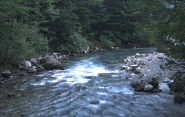Simplifying A Very Complicated System Pays Off For Researchers

Understanding how the flow of water affects a riverbed’s sediment is no easy trick. Complexities like grain-grain friction, non-spherical grain shape, and fluid turbulence figure into it. The amount of energy lost when grains collide also contributes to how grains move.
“Erosion of granular beds is an incredibly complex problem,” said Abram Clark, a postdoctoral research associate in the lab of Prof. Corey O’Hern in the department of Mechanical Engineering & Materials Science. “The problem is that if you try to include all of these complexities in the simulation, it’s difficult to isolate the controlling physical mechanism.”
Essentially, if you include only a few ingredients and you get results that are qualitatively accurate, this actually gives you a better idea of what’s important. Clark, O’Hern and other researchers developed a computer simulation that takes a minimalist approach to analyzing the mechanics of a fluid flowing over a granular bed – for instance, a river running over gravel. The paper, “Onset and Cessation of Motion in Hydrodynamically Sheared Granular Beds,” was recently published in Physical Review.
 “We used simple simulations with two key parameters: the speed of the fluid flow and the strength of the coupling between the fluid and the grains,” said Clark, the lead author of the paper. “And we neglect many of the details - including turbulence in the fluid, irregular shape of the grains, and friction.”
“We used simple simulations with two key parameters: the speed of the fluid flow and the strength of the coupling between the fluid and the grains,” said Clark, the lead author of the paper. “And we neglect many of the details - including turbulence in the fluid, irregular shape of the grains, and friction.”
Their numerical studies were able to explain numerous experimental results, some dating back more than 80 years. And by keeping their model simple, the study suggests that the competing forces of grain inertia and fluid viscosity can explain much of the behavior of fluid-driven granular beds.
In other words, trying to simulate nature exactly as it is may not be the best approach to understanding natural phenomena. For instance, let’s say you want to understand how rocks pack together. Even though rocks aren’t frictionless spheres, researchers can treat them as such and determine whether the simple model explains the packing behavior, and add complexities as necessary.
“You can strip down a complicated physical system to include only two or three effects that you think are the minimal features necessary to explain a particular physical phenomenon,” he said. “Then you write down the equations of motion, integrate them using a computer, and then you are essentially doing numerical `experiments’ of a system that mimics nature.”
Paring down a physical system also allows for a much more nimble research process. Clark points to one of the studies that his paper cites on slurry flows that included a much more complicated treatment of both the fluid and the grains, but presented only a few simulations.
“If you include all of the possible physical effects, you can only run a handful of simulations. And, even if you get the right answer, you’re not sure which parts mattered and which ones didn’t.” But by modeling the granular bed as frictionless disks of two sizes, Clark said, they could perform millions of simulations.
The ability to run millions of simple simulations also revealed that motion in the granular bed was always initiated by the weakest structures in the packing of grains.
“A particular section of the packing will start to move and it will move in such a way that it will cause all of the particles to flow,” he said. “What we showed was that if you have a system that’s double the size, then you’re more likely to find a weak spot that will fail.”
The paper’s other co-authors are Mark D. Shattuck and Nicholas T. Ouellette.

